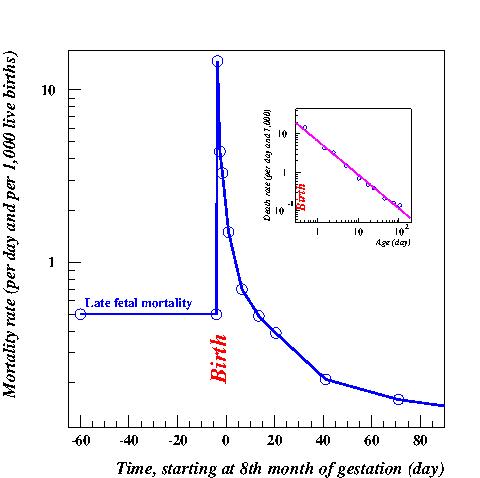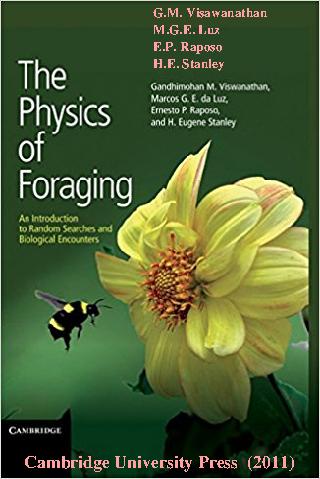 Effect of marital status on death rates.
Part 2: Transient mortality spikes.
Effect of marital status on death rates.
Part 2: Transient mortality spikes.
Physica A 450,768-784 (January 2016)
 A precursor foray into the field of biodemography
as seen by physicists was made in 2011
with the publication of a study entitled
``The physics of foraging''.
A precursor foray into the field of biodemography
as seen by physicists was made in 2011
with the publication of a study entitled
``The physics of foraging''.
For physicists biodemography is an appealing field because
demographic data are less noisy than many other kinds of
social science data, e.g. prices or transaction volumes on stock markets.
This is not because demographic variables are recorded more
accurately but rather because demographic phenomena are
less subject to high-frequency exogenous shocks
and are therefore less volatile.
In addition, demographic data are available online through
a number of convenient websites, e.g. WONDER, IPUMS, VSUS,
UN Demographic Yearbooks.
Moreover, historical
demographic data going back to the mid-19th century
are also available online
(or in recapitulative paper volumes) for a number of countries.
By combining such databases, it becomes possible to
conduct research in a quasi-experimental way.
Testable predictions
In what sense should the expression ``systems biology'' be
understood?
Many demographic effects occur not only in human
populations but also in a broad range of species.
The great merit of
a systems science perspective is that it leads
to testable predictions.
As an illustration,
paper no 7 gives conclusive predictions for the postnatal
mortality spikes of various fish species.
Moreover, even for effects which are specific to humans,
we make a point of checking their similarity in different
developed countries for which data are available.
(2)
Incidence of the Bertillon and Gompertz effects on the
outcome of clinical trials.
Physica A 344, 300-307 (July 2014)
(3)
Symmetry breaking on density in escaping
ants: experiment and alarm pheromone
model
Plos One (31 December 2014)
(4)
How can one explain changes in the monthly pattern of suicide?
Physica A 424,350-362 (January 2015)
(5)
Predictive implications of Gompertz's law.
Physica A 447,446-454 (December 2015)
(6)
Effect of marital status on death rates.
Part 1: High accuracy exploration of the Farr-Bertillon effect.
Physica A 450,748-767 (January 2016)
(7)
 Effect of marital status on death rates.
Part 2: Transient mortality spikes.
Effect of marital status on death rates.
Part 2: Transient mortality spikes.
Physica A 450,768-784 (January 2016)
(8)
Deciphering infant mortality.
Physica A 463,400-426 (July 2016)
(9)
Effect of isolation on life expectancy of Red Imported
Fire Ants (Solenopsis invicta) and Tephridid fruit fly
(Bactrocera dorsalis)
Acta Ecologica Sinica 36,252-255 (July 2016)
(10)
Is cancer a disease that can be cured?
An answer based on a new classification of diseases.
The alternative title used in Physica A is:
A 2-d classification of
diseases based on age-specific death rates.
arXiv:1609.08285 (Sep 2016)
Physica A 492,2281-2291 (Dec 2017)
(10 review)
Lifespan limits
This is a review of (9) written by Mark Buchanan and
published in ``Nature Physics'' of November 2016
(11)
Age spectrometry of infant death rates as a probe of immunity:
identification of two peaks due to
viral and bacterial diseases respectively
Physica A 486,915-924 (June 2017)
(12)
Excess-tuberculosis-mortality in young women: high accuracy
exploration
Preprint 2017, arXiv:1802.00744
Physica A 506,476-485 (Sept 2018)
(13)
Impact of marital status on health.
Physica A 486,542-553 (June 2017)
(14)
Exploration of the strength of family links.
Physica A 502,1-13 (March 2018)
(15)
Coupling between death spikes and birth troughs.
Part 1: Evidence.
Preprint (Oct 2017) arXiv:1801.04533
Physica A 506,97-111 (April 2018)
(16)
Coupling between death spikes and birth troughs.
Part 2: Comparative analysis of salient features.
Preprint (Oct 2017) arXiv:1801.04535
Physica A 506,88-96 (April 2018)
(17)
Deciphering the fluctuations of high frequency birth rates.
(Feb 2018) arXiv:1802.08966
Physica A 509,1046-1061 (June 2018)
(18)
Effect of population density on epidemics.
Preprint (Mar 2018) arXiv:1803.03809
Physica A 510,713-724 (April 2018)
(19)
A physicist's view of the similarities and differences
between tuberculosis and cancer,
Preprint (Mar 2018) arXiv:1801.09528
Physica A 534,1-18 (May 2019)
(20)
The influence of Lent on marriages and conceptions explored
through a new methodology.
Preprint (Mar 2018) http://arxiv.org/abs/1804.02572
Physica A (June 2019)
(21)
The physics of large scale food crises.
Preprint: http://arxiv.org/abs/1807.05100
Physica A 522,274-293 (May 2019)
(22)
Congenital anomalies from a physics perspective.
The key role of manufacturing volatility.
Preprint (May 2019): https://arxiv.org/abs/1905.04357
Physica A 537,1-22 (September 2019)
(23)
Infant mortality across species.
A global probe of congenital abnormalities.
Preprint (May 2019): https://arxiv.org/abs/1905.02621
Physica A 535,1-20 (August 2019)
(24)
Magnitude and significance of the peak of early embryonic mortality.
Journal of Biological Physics, 17 August 2020.
(25)
Physical models of infant mortality: implications for defects
in biological systems.
Journal of Biological Physics 46,371-394. (2020)
(26)
Mortality: a physics perspective.
Physica A 566,1-13 (2021)
(27)
A joint explanation of infant and old age mortality
Journal of Biological Physics 47,131-141 (2021)
(28)
Impact of personal income on mortality: decomposition into
biological vs. socio-economic effects.
European Physics Letters 135,14002-p1-14002-p6 (2021)
(29)
On the mortality of companies.
Entropy 24,208 (Jan 2022)
(30)
Effect of isolation on life expectancy
of red imported fire ant
Solenopsis invicta and tephritid fruit fly Bactrocera dorsalis.
Lei Wang, Yijuan Xu, , Zengru Di, Bertrand M. Roehner
Abstract
The influence of conspecific interactions on behavior of
individuals is an interesting topic, but with elusive proof.
Here,
we studied one species of ants, Solenopsis invicta
(which is a social insect),
and one species of tephritid fruit fly, Bactrocera dorsalis
(which is a non-social but gregarious insect), to determine whether
the lifespan of organisms could
be affected by changes in the number of individuals interacting.
In
our experiments, isolated individuals (singles),
and individuals that were
by groups of 10 were compared.
We found that singles had
a shorter life expectancy than grouped individuals. We also observed
an upsurge of death in 3-4 days after isolation in both species.
This observation suggests that a transition brought about
by changes in the number of contacts
affects both S. invicta and B. dorsalis.
Our study showed that this lifespan effect was
not limited to eusocial insects. Further exploration of this
transition is recommended.
Published in: Acta Ecologica Sinica (2016).